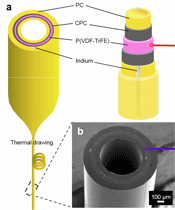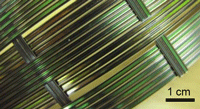刚刚看到的一篇报道,宣称可能是一种喇叭技术的创新。请楼里的高手品评
Woven Speakers
Another recent research report may have an impact on audio transducer technology such as headphones, microphones, or, even more speculatively, loudspeakers. Researchers at MIT and Harvard report in Nature Materials on the manufacture of “Multimaterial piezoelectric fibres.” The piezoelectric effect has been used before at audio frequencies, but usually in very inexpensive and poorly performing headphones and microphones typically utilizing bulk piezoelectric crystals. One Japanese company, Take T, uses a piezoelectric film in its tweeters and super-tweeters. (I have no idea what their products sound like, but their website is entertainingly crazy). That's probably because piezo drivers work their best at high frequencies.
The same holds for the fibers described in the far more sober Nature Materials paper. In it, the researchers describe how a cylindrical sandwich shell of selected materials can be drawn into thin fibers with piezoelectric properties. In the illustration, from the outside in, the layers are polycarbonate (PC), carbon-loaded polycarbonate (CPC), and Poly(vinylidene-fluoride-Trifluoroethylene) copolymer (P(VDF-TrFE)). Indium makes up the electrical contacts. The whole assembly is drawn in a furnace (230o C) into fibers more than 100m long. It is the drawing process itself that confers piezoelectric properties on the P(VDF-TrFE) layer.
 此主题相关图片如下:10_10.gif
此主题相关图片如下:10_10.gif

Other fiber geometries are possible and the supplement to the main paper illustrates how a flat fiber starting out as a “preform” 32mm in width, 11mm in thickness, and 25cm long is drawn into a fiber about 2000 micrometers (2mm) in width, 600 micrometers thick, and several hundred meters long. It is these fibers, woven into a sheet, that made the cover of the journal.

此主题相关图片如下:10_11.gif



 加好友
加好友  发短信
发短信

 Post By:2010-8-7 17:04:27 [只看该作者]
Post By:2010-8-7 17:04:27 [只看该作者]


 加好友
加好友  发短信
发短信

 Post By:2010-8-7 17:05:02 [只看该作者]
Post By:2010-8-7 17:05:02 [只看该作者]


 加好友
加好友  发短信
发短信

 Post By:2010-8-7 17:06:22 [只看该作者]
Post By:2010-8-7 17:06:22 [只看该作者]


 加好友
加好友  发短信
发短信

 Post By:2010-8-7 17:14:15 [只看该作者]
Post By:2010-8-7 17:14:15 [只看该作者]
